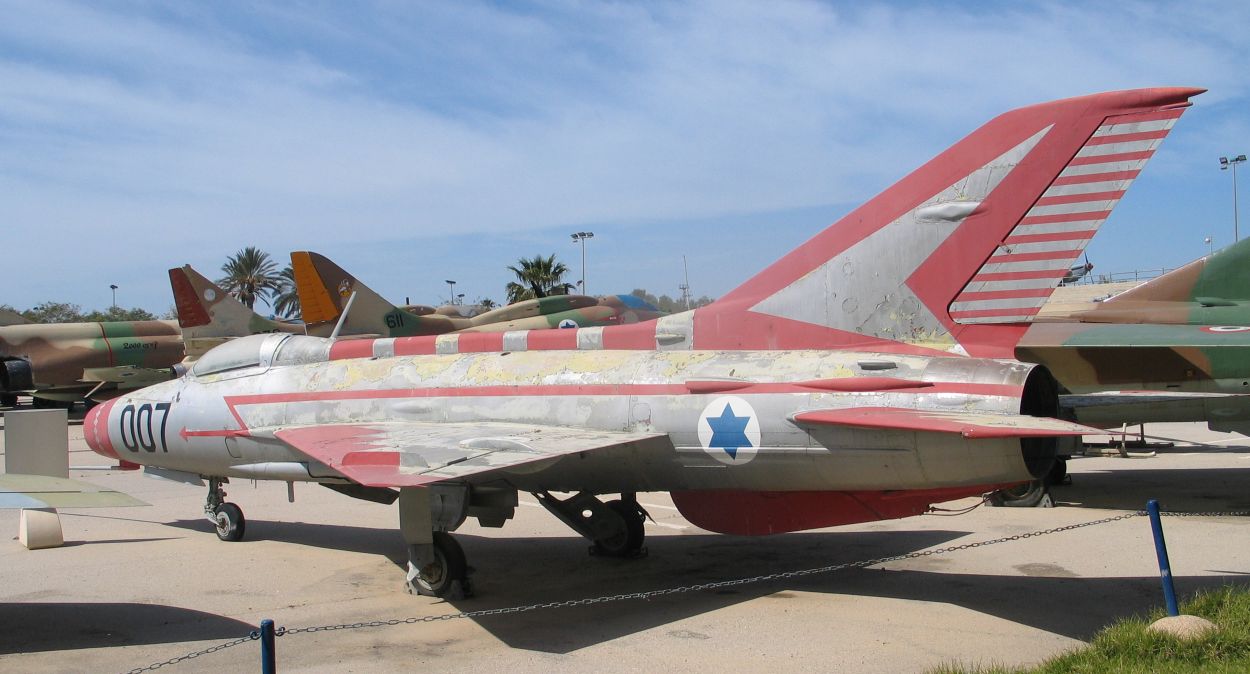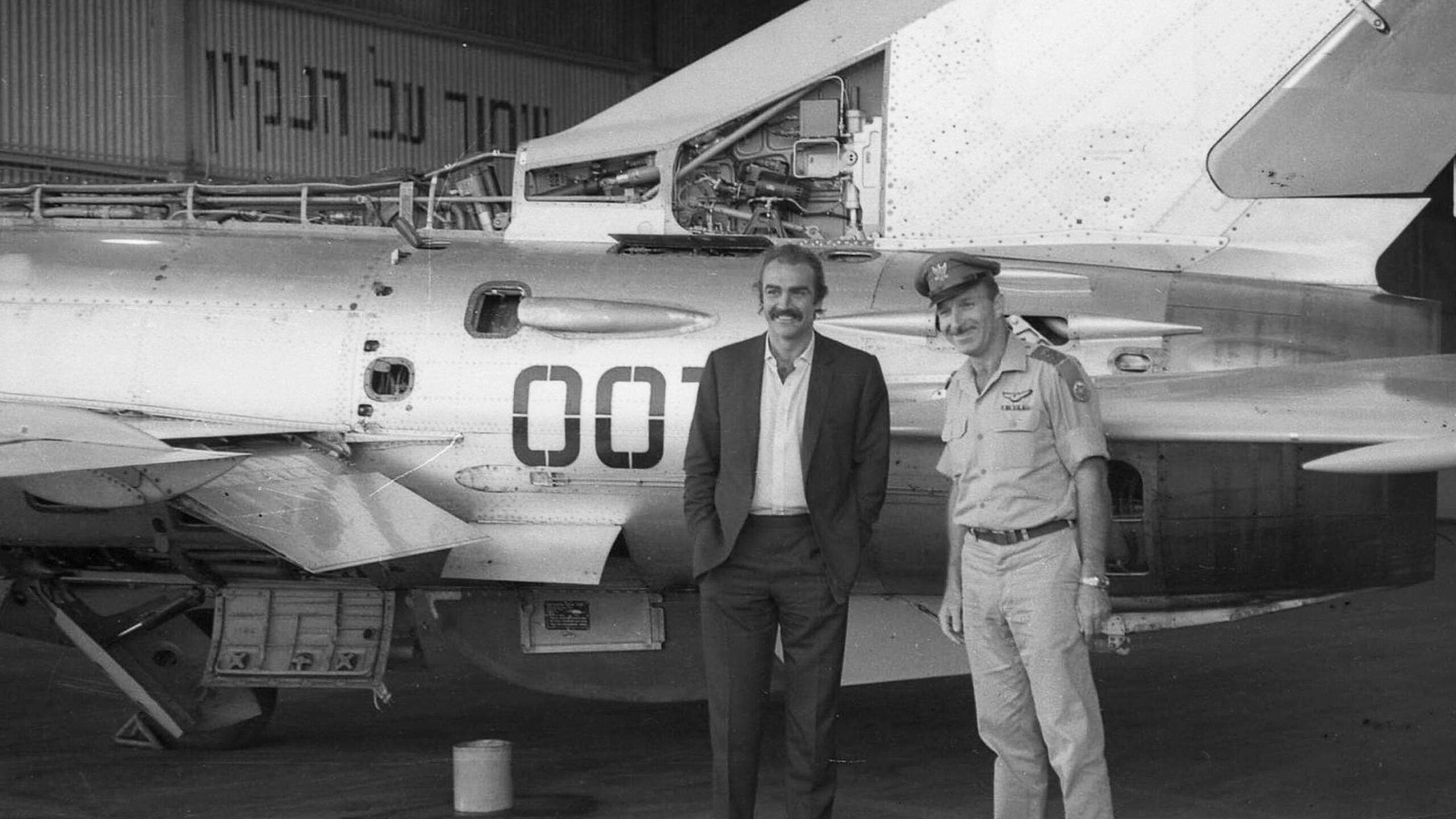The death of the actor Sean Connery at the age of 90 this weekend saw accolades from across the worlds of cinema, celebrity, politics, and more. Among those acknowledgments of Connery’s passing was an intriguing photo posted on the Israeli Air Force’s Twitter feed, which showed the late actor posing alongside a MiG-21 with the number “007” painted on the side, a reference to the fictional British super-spy James Bond, who the movie star had played in multiple films. The story of how the Israeli intelligence agency Mossad brought this Iraqi jet back to Israel is an extraordinary one, the result of an intelligence coup that could itself have been lifted straight from a Bond movie.
Sean Connery died in his sleep on October 31, 2020, after a period of illness. The Scottish-born actor was perhaps best known for playing Bond in the first film in that franchise, Dr. No, in 1962, and other movies in the series. The British Royal Navy veteran also took on many memorable roles in war and action movies including The Longest Day, A Bridge Too Far, The Hunt for Red October, and The Rock.
Other security services beyond the Israeli Air Force (IAF) also acknowledged Connery’s passing.
The IAF’s Twitter post is certainly the most eye-catching, however.
“In 1967,” the accompanying text read, “Connery visited Israel and took this historic picture with then IAF Commander Maj. Gen. Moti Hod with the background of an Iraqi MiG-21, numbered ‘007’ after Bond. RIP.”
It’s not exactly clear why Connery was in Israel, although the visit seems to have occurred in November 1967, after the Six-Day War fought in June between Israel and its Arab neighbors.
The most well-known part of the story begins with the Iraqi Air Force MiG-21F-13 Fishbed — among the very first production versions of this iconic Soviet-made jet — landing at Hatzor Air Base in central Israel, on August 16, 1966. At the controls was an Iraqi defector, Munir Redfa. When touching down in Israel, the jet still wore its Iraqi Air Force markings and carried the Arabic serial number “534” on its nose.
Redfa was an ethnic Assyrian and a Christian. As such, according to the Israeli official account, he saw no future for himself amid the religious and ethnic persecution that accompanied the increasingly turbulent Iraqi politics of the mid-1960s. Redfa, it is said, requested political asylum, and in return, Israel now had one of the most capable jet fighters flown by its adversaries in its possession.
Taking this evidence alone, the covert acquisition of the Fishbed — under an operation known to Mossad by the codename Diamond and to the Israeli Air Force as Blue Bird — was a success. The reality was much more complex and left a bloody trail of destruction in its wake.
Operation Diamond
From at least as early as 1960, Israel launched efforts to encourage Arab military pilots to defect with their aircraft, in order to fully analyze their capabilities. In Israel’s Secret Wars, Ian Black and Benny Morris record how, beginning in that year, Jean Leon Thomas, an agent working in Egypt for Israel intelligence, apparently offered cash rewards to Egyptian Air Force pilots to defect to Israel. This early plan backfired after the agent was reported to the Egyptian Air Force Police and then arrested, along with five suspected accomplices. Thomas and two others were executed in December 1962.
Israel did get its hands on a defecting Egyptian aircraft in 1964, but the piston-engined Yakovlev Yak-11 Moose trainer, which first entered Soviet service in the immediate aftermath of World War II. It was hardly the intelligence windfall that it had hoped for. The pilot in question, Captain Mohammad Abbas Helmy, emigrated to South America, where he was assassinated soon after, according to the account provided in Arab MiGs — Volume 2, by Tom Cooper and David Nicolle.
Mossad then saw its opportunity to get the intelligence on the cutting-edge fighter jets that it needed when it learned that a group of Iraqi Air Force pilots were due to start training on staff courses at Randolph Air Force Base in Texas, in early 1965. The tipoff came from a Mossad contact in Baghdad, the Iraqi capital. His codename was “Yusuf,” and he was an — allegedly — illiterate Iraqi Jew who would play a central role in the story. In the account provided by Ephraim Kahana in Strategic Intelligence, Yusuf’s information was passed to Mossad via Iran, which at that time maintained good relations with Israel.
The agency’s plan reportedly involved deploying female agents to lure the Iraqi pilots in a classic “honeytrap” operation. One of those Iraqi pilots, Hamid Dhahee, was reportedly shot to death in a Texas bar, in June 1965, after apparently refusing the defection proposal offered by one of the agents.

It seems that the Iraqi Air Force wound up its training program in the United States soon after, but not before Mossad’s agents had managed to establish “relationships” with at least three more of the pilots, and then followed them back to Iraq. One of these contacts quickly broke down, however, leading to an Iraqi Air Force captain reportedly being shot dead in a Baghdad apartment by a local Mossad informant, in July 1965.
A second Iraqi Air Force pilot reportedly met a similar fate, being thrown out of a train while visiting Germany for medical treatment in February 1966. According to Iraqi Air Force accounts, this pilot was assassinated after making excessive financial demands in exchange for his defection.
The third Iraqi pilot was Captain Munir Redfa. He was married, but had supposedly had an affair — with an Israeli agent — while in the United States. Redfa also had a family connection to the agent Yusuf, being married to his girlfriend’s sister.
According to Israeli accounts, Redfa was the most suitable candidate for Operation Diamond as he had been passed over for promotion in the past and was unhappy at having to fly combat missions against the Iraqi Kurds, another marginalized ethnic group in the country.
An alternative account points to Redfa’s appointment as commanding officer of his squadron and the fact he was trusted to attend a training course at Randolph, where the possibility of defection was real.
Ephraim Kahana contends that the relationship between Redfa and the female Mossad agent was set up in Europe, where the two holidayed together in July 1966. In this account, the agent encouraged Redfa to fly with him to Israel, where he was “given VIP treatment” and offered citizenship and a reward of $1 million. If true, this seems like an extraordinary risk to have taken, should the Iraqi authorities have found out once he returned to his country.
Kahana also says that during his visit to Israel, Redfa met in person with Major General Mordechai “Moti” Hod — the commander of the Israeli Air Force who was later photographed with Connery and the prized “007” jet.
Other meetings that seem certain to have happened involved Redfa and the female Mossad agent that he had met in the United States. Reportedly, they met frequently in Baghdad and it seems likely that Mossad would have gathered evidence that could be used to compromise the Iraqi pilot if required.
Whatever the truth of the matter, confronted by the evidence of his affair, a generous financial incentive, offer of Israeli citizenship, and with two of his colleagues apparently already assassinated, it seems that Redfa saw little option but to defect.
After Mossad had helped his family members’ safe evacuation to Iran, to avoid possible recriminations from the Iraqi authorities, Redfa broke off from a routine navigation training mission from Habbaniyah Air Base, west of Baghdad, on August 16, 1966. He turned west, passing over Jordan at a high level, putting his MiG-21 beyond the reach of Royal Jordanian Air Force Hawker Hunter jet fighters that were reportedly sent to intercept him. Once in Israeli airspace, he was met by a pair of Israeli Air Force Mirage IIICJ fighters, which escorted him into Hatzor.

Despite the secrecy surrounding the background of the operation, Israel was quick to show Redfa’s MiG-21F-13 to the foreign press soon after its arrival. That the country was happy to at least reference the cloak-and-dagger approach to securing the jet is made clear by the application of the “007” serial number sometime before Connery’s November 1967 visit to Israel.
At some point the Fishbed received outsized Syrian Arab Air Force markings, apparently to increase the level of realism for the dissimilar air combat training sessions staged for Israeli Air Force pilots. A thorough study of the jet in the course of over 100 hours of flight testing within a 12-month period — and intelligence debriefing of Redfa — provided Israel with plenty of valuable data on the fighter’s capabilities. All this knowledge would be put to good use in subsequent air wars with the country’s Arab neighbors, beginning with the Six-Day War of June 1967.
Remarkably, the MiG-21F-13 was also pressed into action by the Israelis in the 1967 conflict, at a time when the Israeli Air Force needed every serviceable aircraft it could lay its hands on. Repainted in high-visibility Israeli markings, it was armed with Israeli-made Shafrir air-to-air missiles. The jet stood on quick reaction alert duty at Hatzor, but Israeli accounts suggest it was never scrambled.
Have Doughnut
As well as providing intelligence to the Israeli Air Force, the ex-Iraqi MiG-21 also took part in the Have Doughnut program in the United States, for which Israel loaned the jet for use by the Air Force Systems Command’s Foreign Technology Division. According to Steve Davies’ account in Red Eagles: America’s Secret MiGs, Israel agreed to the transfer only on the condition that the United States would sell it F-4 Phantom II fighter jets in return.

The “007” jet was active in the United States between January and April 1968, completing 102 flights and 77 flying hours, operating over Groom Lake, Nevada, using the designation YF-110. This clandestine program was a forerunner to Constant Peg, during which a variety of captured and acquired Soviet-made fighter jets were operated under extreme secrecy from Nevada’s Tonopah Test Range Airport in the late 1970s and 1980s.

While an aircraft painted to resemble the ex-Iraqi MiG-21 is now on display at the Israeli Air Force Museum in Hatzerim, very few details about the subsequent life of its pilot, Munir Redfa are available. Redfa, however, is known to have remained in Israel, where he died of a heart attack in “around 1998.”
On the other hand, much like James Bond himself, the legend of the “007” MiG-21 looks set to endure.
Contact the author: thomas@thedrive.com
